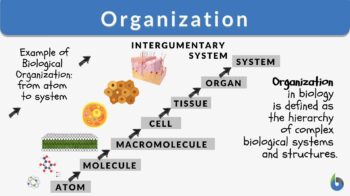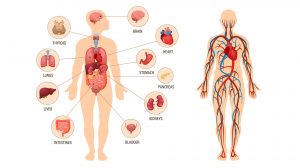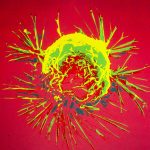
Organization
n., plural: organizations
[ˌɔɹɡənaɪˈzeɪʃən]
Definition: In biology, an arrangement of parts in a systematized manner
Table of Contents
Organization Definition
The meaning of the term “organization” is very simple. It means the state wherein things are organized and arranged in a particular manner. That’s the “general” sense of the term. In science, “organization” is defined as the arrangement of parts for the performance of functions that are essential for life. (McKendrick, 2021).
Organization in a biological sense refers to the hierarchy of complex biological systems and structures. Biological organizations can explain life by using a reductionist approach. This biological hierarchy starts from the smallest level, atom, and extends to a higher level, the biosphere. The higher level which is the biosphere is sometimes referred to as the ecological hierarchy. (License, 2021).
Each next level in the biological hierarchy shows a more organizational complexity. Each object of the next level is composed of the basic units of the previous level. In scientific research, more in medical sciences, the role of the organization of life is very fundamental. Without the organization, it becomes difficult or nearly impossible to study the effects of different chemical and physical phenomena on body functions and diseases. Change in a single atom can cause changes in the entire biosphere.
An organization is the hierarchy of complex biological systems and structures. For example, the cell is regarded as the fundamental form of organization. Each next level in the biological hierarchy shows a more organizational complexity. Each object of the next level is composed of the basic units of the previous level.Etymology: Middle French organisation
Variant: organisation (British)
Organization Examples
The order of the hierarchy of life is one of the prominent examples of an organization as explained by Paul Andersen. He explains it at the following levels (Andersen, 2021):
Atoms, Molecules, Cell, Tissue, Organ, Organ System, Organism, Population, Community, Ecosystem, and Biosphere

The emergence of biological organization
It is thought that biological organization emerges from the RNA world. According to Charles Darwin, the type of variation, heredity, and competition due to limited resources are some conditions due to which RNA chains show some basic adaptive changes.
The three main adaptive changes are:
1. Capability to avoid decay
2. Capability to replicate
3. Capability to acquire the resources
These capabilities or capacities are encoded in the nucleotide sequence of RNA. In recent organisms, the competitive success at the subsequent levels of the biological organization depends on the adaptability of these capabilities.
Levels of organization in biology
Levels of organization of living things follow a hierarchy in a structured and organized way. The fundamental and smallest unit of matter is an atom. It has a nucleus that is surrounded by electrons. (The viruses are not made up of cells; that’s the major reason the viruses are not considered living. For reproduction, they invade the reproductive mechanism of another cell.)
Molecules are formed when two or more atoms are detained together by a chemical bond. Macromolecules (larger molecules) formed by polymerization, are important biologically. One of the major examples of macromolecules is Deoxyribonucleic acid (DNA). DNA had the instructions for the function and structure of the living organism. When macromolecules aggregate and are surrounded by a membrane, organelles are formed. Organelles perform the necessary function.
Some organisms are multicellular or some are unicellular. There are two major categories of cells called prokaryotes or eukaryotes. Prokaryotes are either colonial or single-celled and they don’t have a membrane-bounded nucleus. Eukaryotes have membrane-bounded organelles and nuclei.
In the larger organism, cells conglomerate to form tissue. The same types of tissues perform related functions. Similar tissues combine and form organs. These organs are available in plants, in addition, present in animals too. The organ system is the higher level of organization, which is formed by the combination of functionally related organs. Different organ systems are present in mammals.
Different organ systems combine and form an individual. Individuals of a species form a population. A specific area may consist of different populations. A community is formed by the summation of populations in a particular area. An ecosystem consists of both biotic and abiotic factors. The biosphere is the highest level of organization, which contains all the ecosystems.
A brief description of levels of biological organization is as follows.
Molecule
The smallest unit of an element is atoms. Two or more atoms combine and form a molecule. In living organisms, molecules form the most basic structures.
Molecules are of two types (Online, 2021a):
- Micro molecules
- Macromolecules
Table 1: Comparison between micromolecules and macromolecules | |
|---|---|
| Micromolecules | Macromolecules |
| These are smaller and have lower molecular weight. | These are larger and have higher molecular weight. |
| Examples: Monosaccharides, nucleotides, fatty acids, amino acids, and glycerol | Examples: Proteins, lipids, carbohydrates, and nucleic acids. |
Cell
The main and basic unit of life is the cell. Cells are grouped and form tissues. There is a major contrast between animal cells and plant cells as mentioned below (CMS, 2021).
Animal Cell vs. Plant Cell | |
|---|---|
| Animal Cell | Plant Cell |
| Cell walls are absent | Cell walls are present; they provide shape and support to plant cells |
| Chloroplast is not available in animals | An important part of plant cells is a chloroplast |
| Animal cells have a small vacuole. | It has one or more than one large vacuole and is associated with osmoregulation and plant cell turgidity. |
| Cholesterol in the cell membrane | Lacks cholesterol |
Tissue
Cells combine and form tissues. Tissues work together and perform a certain task. There are different types of tissues.
For example, neural tissue, muscle tissue, and connective tissue
Organ
Systems of tissues that work together, form an organ. An organ performs a certain task. Different organs are present in animal and plant bodies.
In animals, liver, stomach, lungs, and heart are present while in plants leaves and stems are found.
Organ System
To perform the body functions, a group of organs work in coordination and form an organ system.
For example, the Circulatory system transports the blood in the body and to and from the lungs. It consists of three organs which are the heart, lungs, and blood vessels.
For example, the transportation of blood by the Circulatory system in the body is to and from the lungs. The heart, blood vessels, and lungs are considered to be the three major organs.
Organism
An organism is considered a living thing that has an organized structure. An organism has different characteristics like it can grow, reproduce, adapt, react to a stimulus and maintain homeostasis. Examples of organisms are plant, animal, protist, fungi, or bacteria. A multi-cellular organism is composed of different organs and organ systems (Online, 2021b).
Population
In a specific area, a population is defined as a group of different organisms of the same species.
For example, a pride of lions in Africa, pine trees in a forest, etc.
Community
In a certain area, all the different species live and form a community.
For example, in the forest of Africa, the population of lions, elephants, gazelles, etc., are living. They form a community.
Ecosystem
All the communities combine and form an ecosystem in a certain area. An ecosystem also contains all the non-living and physical parts of an environment. For example, rock, dirt, and water are a part of an ecosystem.
Biosphere
All the ecosystems on Earth are added together and form a biosphere. Biospheres represent the zone of life on Earth. Every molecule, rock, plant, animal, and bacteria are part of Earth’s biosphere (McKendrick, 2021).
Following is the display of organization:

Try to answer the quiz below to check what you have learned so far about biological organization.
Reference
- Andersen, P. (2021). Hierarchy of Life. Retrieved 7, September 2021, from http://www.bozemanscience.com/hierarchy-of-life
- Biologyonline. (2021a). Micromolecule. Retrieved 07, September 2021, from https://www.biologyonline.com/dictionary/micromolecule
- Biologyonline. (2021b). Organism. Retrieved 07, September 2021, from https://www.biologyonline.com/dictionary/organism
- CMS, S. (2021). Plant & Animal Cell Differences Genetics. Retrieved 07, September 2021, from https://www.spart1.org/PlantAnimalCellDifferencesGeneticsNotes.aspx
- License, C. C. A.-S. (2021). Biological organisation. Retrieved 07.September 2021, from https://en.wikipedia.org/wiki/Biological_organisation
- McKendrick. (2021). Organization. Retrieved 07, September, 2021, from https://www.biologyonline.com/dictionary/organization
©BiologyOnline.com. Content provided and moderated by Biology Online Editors.




